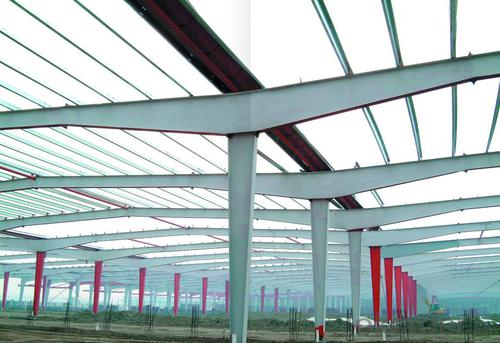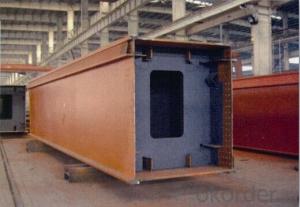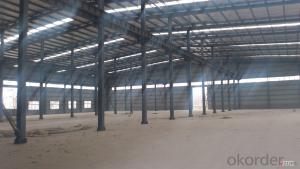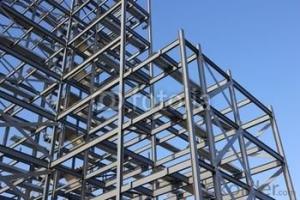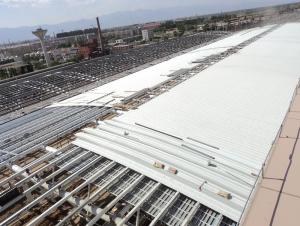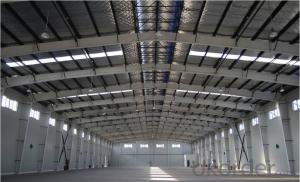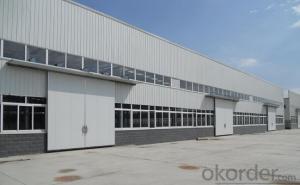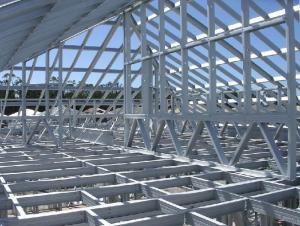High Quality Light Steel Workshop
- Loading Port:
- Nantong
- Payment Terms:
- TT OR LC
- Min Order Qty:
- -
- Supply Capability:
- 200000 m.t./month
OKorder Service Pledge
OKorder Financial Service
You Might Also Like
Technical support of light steel structure workshop
Worker | Rate of frontline workers with certificate on duty reaches 100% |
Welder | 186 welders got AWS & ASME qualification 124 welders got JIS qualification 56 welders got DNV &BV qualification |
Technical inspector | 40 inspectors with UT 2 certificate 10 inspectors with RT 2 certificate 12 inspectors with MT 2 certificate 3 inspectors with UT3 certificate |
Engineer | 21 engineers with senior title 49 engineers with medium title 70 engineers with primary title. 61 First-Class Construction Engineers 182 Second-Class Construction Engineers |
International certification | 10 engineers with International Welding engineer, 8 engineers with CWI. |
Production Flow of steel structure
Material preparation—cutting—fitting up—welding—component correction—rust removal—paint coating—packing—to storage and transportation (each process has the relevant inspection)
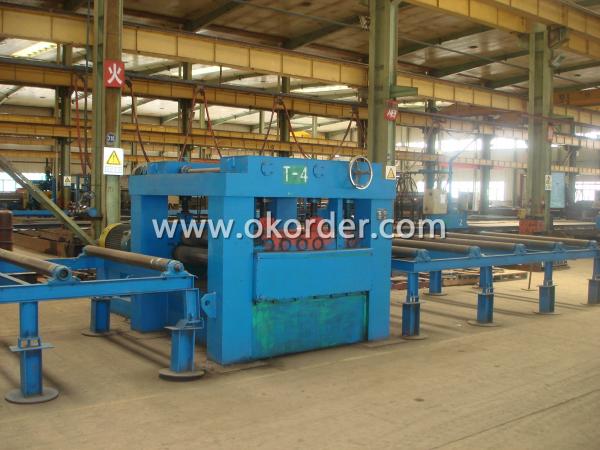 |  |
*Characters of Structure Steel
1. Steel is characterized by high strength, light weight, good rigidity, strong deformation capacity, so it is suitable for construction of large-span, super high and super-heavy buildings particularly;
2. It with good homogeneous and isotropic, is an ideal elastomer which perfectly fits the application of general engineering;
3. The material has good ductility and toughness, so it can have large deformation and it can well withstand dynamic loads;
4. Steel structure’s construction period is short;
5. Steel structure has high degree of industrialization and can realize-specialized production with high level of mechanization.
*Steel structure application
1. Heavy industrial plants: relatively large span and column spacing; with a heavy duty crane or large-tonnage cranes; or plants with 2 to 3 layers cranes; as well as some high-temperature workshop should adopt steel crane beams, steel components, steel roof, steel columns, etc. up to the whole structure.
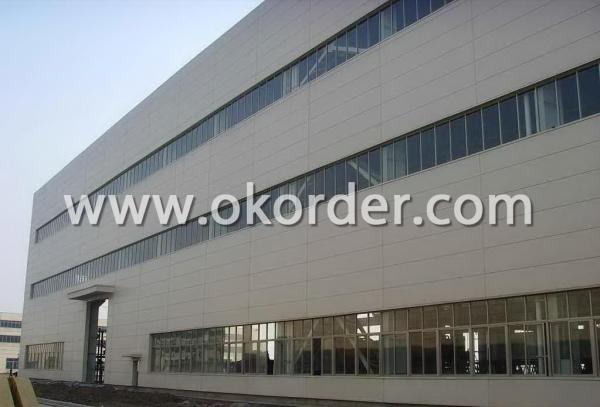
2. Large span structure: the greater the span of the structure, the more significant economic benefits will have by reducing the weight of the structure
3. Towering structures and high-rise buildings: the towering structure, including high-voltage transmission line towers, substation structure, radio and television emission towers and masts, etc. These structures are mainly exposed to the wind load. Besides of its light weight and easy installation, structure steel can bring upon with more economic returns by reducing the wind load through its high-strength and smaller member section.
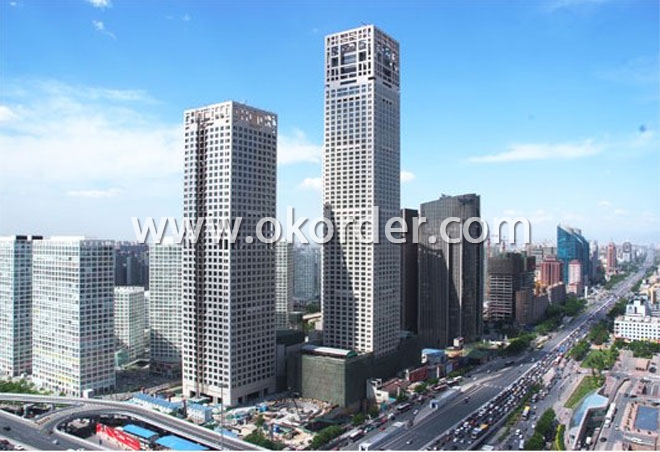
4. Structure under dynamic loads: As steel with good dynamic performance and toughness, so it can be used directly to crane beam bearing a greater or larger span bridge crane
5. Removable and mobile structures: Structure Steel can also apply to movable Exhibition hall and prefabricated house etc by virtue of its light weight, bolt connection, easy installation and uninstallation. In case of construction machinery, it is a must to use structure steel so as to reduce the structural weight.
6. Containers and pipes: the high-pressure pipe and pipeline, gas tank and boiler are all made of steel for the sake of its high strength and leakproofness
7. Light steel structure: light steel structures and portal frame structure combined with single angle or thin-walled structural steel with the advantages of light weight, build fast and steel saving etc., in recent years has been widely used.
8. Other buildings: Transport Corridor, trestle and various pipeline support frame, as well as blast furnaces and boilers frameworks are usually made of steel structure.
All in all, according to the reality, structure steel is widely used for high, large, heavy and light construction.
- Q: What factors need to be considered when designing steel structures?
- When designing steel structures, several factors need to be considered, including the load-bearing capacity required, the intended use and function of the structure, the environmental conditions it will be subjected to, as well as any applicable building codes and regulations. Other factors include the type and quality of steel to be used, the structural stability and integrity, as well as the aesthetics and cost-effectiveness of the design. Moreover, factors like ease of construction, maintenance requirements, and potential for future modifications or expansions should also be taken into account during the design process.
- Q: How are steel structures designed to accommodate natural lighting and ventilation?
- Steel structures can be designed to accommodate natural lighting and ventilation in several ways. One common approach is to incorporate large windows or glass panels into the design of the structure. These windows or panels can be strategically placed to allow natural light to enter the building and illuminate the interior spaces. Additionally, these openings can be designed to facilitate cross ventilation, allowing fresh air to flow through the building and improve air quality. Another method is to incorporate skylights or roof vents into the steel structure. Skylights are transparent or translucent panels that are installed on the roof, allowing natural light to enter the building from above. This not only helps to reduce the need for artificial lighting during the day but also creates a visually appealing and vibrant atmosphere. Roof vents, on the other hand, can be designed to open and close, allowing hot air to escape and fresh air to enter the building, promoting natural ventilation. Steel structures can also be designed with open floor plans or high ceilings to maximize the distribution of natural light throughout the building. By eliminating unnecessary partitions or walls, light can easily penetrate into different areas, reducing the need for artificial lighting during the day. Additionally, the use of light-colored materials for the interior finishes can help reflect and amplify natural light, further enhancing the overall brightness of the space. Furthermore, steel structures can be designed with shading devices or louvers to control the amount of sunlight entering the building. These devices can be adjusted to block direct sunlight during certain times of the day, preventing overheating and glare while still allowing diffused natural light to enter the space. This helps to maintain a comfortable indoor environment and reduces the need for excessive cooling or shading systems. Overall, through thoughtful design and the incorporation of various elements such as windows, skylights, roof vents, open floor plans, and shading devices, steel structures can be effectively designed to accommodate natural lighting and ventilation, creating a more sustainable and comfortable environment for occupants.
- Q: What are the design considerations for steel canopies and outdoor seating areas?
- When designing steel canopies and outdoor seating areas, there are several key considerations that need to be taken into account. These considerations include: 1. Structural Integrity: Steel canopies and outdoor seating areas need to be built with a strong and stable structure to ensure they can withstand various weather conditions, such as heavy rain, snow, and strong winds. The design should be able to support the weight of the canopy itself, as well as any additional loads that may be placed on it, such as lighting fixtures or hanging plants. 2. Durability: Steel is chosen for its durability, but the design should also take into account the potential for corrosion or rust. Proper coatings or finishes can be applied to protect the steel from the elements and increase its lifespan. 3. Aesthetics: The design of the steel canopy and outdoor seating area should be visually appealing and complement the surrounding environment. Considerations such as shape, color, and style should be taken into account to ensure that the design fits seamlessly into its surroundings and enhances the overall aesthetic appeal of the space. 4. Functionality: The design should consider the intended use of the space. Outdoor seating areas should be comfortable and accommodating, with proper spacing and seating arrangements to accommodate different group sizes. Canopies should provide adequate shade and protection from the elements, while also allowing for proper ventilation and airflow. 5. Accessibility: It is important to ensure that the design of the steel canopy and outdoor seating area is accessible to all individuals, including those with disabilities. This may involve incorporating features such as ramps, handrails, and accessible seating options to comply with accessibility guidelines and regulations. 6. Maintenance: The design should take into account the ease of maintenance and cleaning. Steel canopies and outdoor seating areas should be designed in a way that allows for easy access and cleaning of all components, including the canopy itself, seating surfaces, and any integrated features or accessories. In conclusion, when designing steel canopies and outdoor seating areas, it is crucial to consider structural integrity, durability, aesthetics, functionality, accessibility, and maintenance. By carefully addressing these design considerations, a well-designed and functional outdoor space can be created, providing a comfortable and visually appealing area for people to relax and enjoy.
- Q: How are steel structures designed and constructed to meet energy efficiency standards?
- Various strategies can be employed to ensure that steel structures meet energy efficiency standards. One crucial aspect is the insulation of the building envelope. By installing insulation materials like foam panels or fiberglass within the steel framing, heat transfer can be reduced, resulting in minimized energy consumption for heating and cooling. Another vital factor is the selection of energy-efficient windows and doors. Opting for high-performance glazing systems, such as double or triple-pane windows with low-emissivity coatings, can effectively decrease heat gain or loss. Furthermore, proper sealing and weatherstripping around windows and doors help prevent air leakage, maintaining a comfortable indoor environment. Moreover, incorporating natural lighting and ventilation into the design of steel structures can decrease the reliance on artificial lighting and mechanical systems. Strategically placing windows, skylights, and light shelves maximizes daylight penetration, thus reducing the need for electrical lighting. Additionally, operable windows or ventilation systems facilitate natural airflow and decrease the requirement for mechanical ventilation, resulting in energy savings. When it comes to heating and cooling systems, steel structures can be designed to accommodate energy-efficient equipment. For instance, utilizing high-efficiency HVAC systems that meet or surpass industry standards significantly reduces energy consumption. Furthermore, integrating renewable energy sources, like solar panels, enhances energy efficiency by generating clean electricity on-site. Lastly, the construction process itself plays a vital role in achieving energy efficiency standards. Proper site orientation and layout optimize energy performance by maximizing solar exposure and minimizing shading. Additionally, using recycled or locally sourced materials for steel production reduces the carbon footprint of the structure. In conclusion, energy efficiency standards can be met in steel structures through insulation, energy-efficient windows and doors, natural lighting and ventilation, efficient heating and cooling systems, renewable energy integration, and sustainable construction practices. By implementing these strategies, steel structures contribute to a more sustainable built environment, reducing energy consumption and greenhouse gas emissions.
- Q: How are steel structures designed to resist water and moisture damage?
- Steel structures are engineered to withstand water and moisture damage by employing various measures. One primary method is the application of protective coatings onto the steel surfaces. These coatings serve as a barrier, preventing direct contact with moisture and reducing the risk of corrosion. Popular protective coatings include paint, epoxy, galvanization, and other materials resistant to corrosion. Furthermore, steel structures often feature well-designed drainage systems to prevent the accumulation or pooling of water on their surfaces. This helps minimize exposure to moisture and prevents potential damage. Moreover, the design of steel structures takes into account the possibility of water and moisture infiltration. This involves incorporating features like sloped surfaces, proper flashing, and sealants to redirect water away from critical areas and prevent it from seeping into the structure. To prevent water and moisture damage, regular maintenance and inspections are essential for steel structures. These procedures involve checking for signs of corrosion or deterioration, addressing any issues promptly, and ensuring the integrity and effectiveness of protective coatings. In conclusion, the design of steel structures considers the necessity of withstanding water and moisture damage by incorporating protective coatings, proper drainage systems, and preventive measures. By implementing these strategies and conducting regular maintenance, steel structures can effectively endure the challenges posed by water and moisture exposure.
- Q: What are the common design considerations for steel structures in parking structures?
- Some common design considerations for steel structures in parking structures include load-bearing capacity, structural stability, durability, and fire resistance. Steel frames are typically chosen for their strength and ability to support heavy loads, such as vehicles and the weight of the structure itself. The design must also ensure that the structure remains stable and can withstand dynamic forces like wind and seismic activity. Additionally, steel structures in parking facilities must be durable to resist corrosion and deterioration from exposure to weather conditions and vehicle emissions. Lastly, fire resistance is crucial to protect the structure and occupants, often achieved through the use of fire-resistant materials and proper ventilation systems.
- Q: How are steel structures designed for transportation hubs?
- The design of steel structures for transportation hubs takes into account several key factors. Firstly, the specific requirements and demands of the transportation hub must be considered. This includes factors such as size, capacity, functionality, and any unique features or architectural considerations. When it comes to functionality, steel structures are often chosen for transportation hubs due to their strength, durability, and versatility. They can withstand heavy loads and provide long-lasting support, making them an ideal choice for hubs with high volumes of foot traffic, vehicle traffic, and various equipment and infrastructure. Designers also need to consider the layout and flow of the transportation hub. Steel structures can be used to create open, flexible spaces that allow for efficient movement of people and goods. This includes designing wide, unobstructed platforms, terminals, and concourses that can accommodate large crowds and provide clear pathways for passengers. Furthermore, steel structures can be designed to integrate with other transportation systems, such as railways, airports, or bus terminals. This requires coordination with other engineering disciplines to ensure seamless connectivity and efficient transfer of passengers and cargo between different modes of transportation. Safety is another crucial aspect of steel structure design for transportation hubs. These structures must be able to withstand environmental factors such as wind, earthquakes, and extreme temperatures. Steel's strength and ductility make it a reliable choice for withstanding these forces, and it also allows for the implementation of safety features such as fire-resistant coatings and advanced structural systems. Lastly, aesthetic considerations are also taken into account when designing steel structures for transportation hubs. These structures play a significant role in shaping the overall appearance and identity of the hub. Architects and designers work closely together to create visually appealing structures that blend harmoniously with the surrounding environment while still meeting the functional requirements of the transportation hub. In conclusion, steel structures for transportation hubs are designed with a focus on functionality, safety, and aesthetics. By carefully considering the specific needs of the hub and utilizing the strengths of steel, designers can create structures that efficiently support the movement of people and goods while enhancing the overall user experience.
- Q: Steel structure platform cost
- The steel structure (General Plant) length: 100 meters wide, 30 meters high, 8 meters (total: 3000 square meters): steel frame (plant): 700 yuan / month (700 * 46=32200) steel: 200 yuan / square meter (200 x 3000=600000) wall: 90 yuan / square meter (90 x 3000=270000) total cost cost: 902200 yuan, 300 yuan / square meters of steel structure service life (25 years)
- Q: Can steel structures be designed to be resistant to corrosion from acidic substances?
- It is possible to design steel structures to resist corrosion caused by acidic substances. A commonly employed technique involves applying a protective coating, such as paint or epoxy, on the steel's surface. This coating acts as a barrier, preventing direct contact between the metal and the corrosive substances. As a result, the risk of corrosion is minimized. Another option is to use stainless steel, which contains a higher amount of chromium. The chromium forms a thin oxide layer on the surface of the steel, providing excellent resistance against acidic substances. Additionally, considering factors like the appropriate steel grade and thickness during the design process can further enhance the structure's overall resistance to corrosion. By implementing these preventive measures and employing careful design, it is indeed possible to create steel structures that can withstand the corrosive effects of acidic substances.
- Q: How are steel structures used in stadiums and sports arenas?
- Steel structures are commonly used in stadiums and sports arenas due to their strength, durability, and versatility. They provide the necessary support for large spans and grandstands, allowing for open and flexible layouts. Steel is also used in the construction of roofs, ensuring protection from weather elements while allowing for natural light. Additionally, steel structures can be easily modified or expanded, making them ideal for accommodating changing needs in stadiums and sports arenas.
Send your message to us
High Quality Light Steel Workshop
- Loading Port:
- Nantong
- Payment Terms:
- TT OR LC
- Min Order Qty:
- -
- Supply Capability:
- 200000 m.t./month
OKorder Service Pledge
OKorder Financial Service
Similar products
Hot products
Hot Searches



